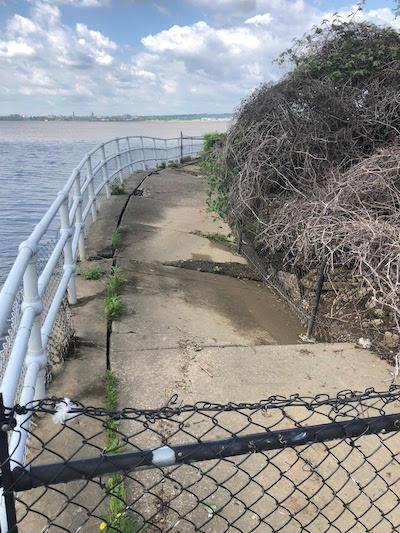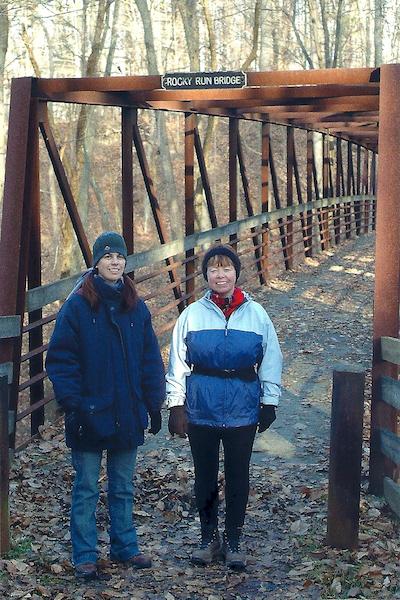
Visitors wanting to hike the Valley Cove Trail in Acadia National Park are blocked from access by this signage/Dolores Kong
Editor's note: In a summer-long series, National Parks Traveler's writers and editors are going beyond the numbers to describe the National Park System's $11.6 billion maintenance backlog. This article looks at how the backlog is impacting visitor access in some units of the National Park System.
By Dolores Kong and Dan Ring
During the Great Depression 80 years ago, the Civilian Conservation Corps moved granite and earth in Acadia National Park to access what park founder George B. Dorr described as “an unusually beautiful shoreline” along Somes Sound.
But for the past two years, the Valley Cove Trail – featuring spectacular views of the East Coast’s only fjord-like feature and “a unique kind of trail construction” with granite steps secured by iron pins across an otherwise impassable ledge – has been shut off to visitors for lack of about $300,000 of repairs. That was just part of the nearly $60 million in deferred maintenance on the books for fiscal 2017 at the park located on Maine’s coast.
In Ohio at Cuyahoga Valley National Park, hikers wanting to climb the low-lying Cuyahoga riverbanks to the top of the valley along a 3.5-mile-loop known as the Old Carriage Trail have been stymied for the last nine years; three steel footbridges across deep ravines have been closed for lack of about $500,000 of repair work each, part of the national park’s $45.81 million maintenance backlog in fiscal 2017.

A chain link fence blocks access to a 60-foot section of East Potomac Park, part of the National Mall where deteriorating sidewalk and seawall have made it unsafe/NPS
In the nation’s capital, visitors can’t reach the top of the Washington Monument for lack of a working elevator, walk along a 60-foot-section at the southern tip of East Potomac Park as a result of deteriorating sidewalk and seawall, or access the west side of the Lincoln Memorial as the roof is being replaced. Deferred maintenance projects such as these at the National Mall and Memorial Parks totaled $657.4 million in fiscal 2017, putting it near the top of National Park System units with the biggest backlog.
From Acadia to Zion, from the “halls” of Montezuma Castle National Monument to the shores of Hawai’i Volcanoes National Park, the National Park Service’s nearly $12 billion deferred maintenance backlog has restricted visitor access to everything from hiking trails to bike paths and archaeological sites to campgrounds. Too, that unaffordable repair work threatens infrastructure, buildings, and other National Park System resources.
The visitor experience at what’s been called “America’s best idea” is at risk of going from best to worst. While National Park System visitation reached a record 330.8 million last year, the Park Service full-time workforce dipped to 19,668 in fiscal 2017 (an 8.8 percent reduction since fiscal 2014), and the deferred maintenance backlog stood at $11.6 billion.
Although parks may plan maintenance work to minimize disruptions to the public, and visitors can take other trails, ride other bike paths, or access any of the other multitudes of resources at a particular site, at some point the constant deferral catches up. More things break down or cost more to fix, visitors get turned off and, in turn, local businesses and jobs may be affected.
During the busy Memorial Day Weekend in Acadia, not only were visitors unable to hike the Valley Cove Trail as a result of deferred maintenance, one urinal (out of two) in the men’s bathroom next to the Cadillac Mountain gift shop was covered by green plastic, and one out of three sinks was out of order, as marked by a large handwritten sign on corrugated cardboard (Cadillac’s wastewater system is on the backlog list), and patrons at the Jordan Pond House had their view of the Bubbles marred by a ripped-up lawn, exposed pipes, and heavy excavating equipment (the four-acre lawn where the traditional afternoon tea is served in season is on the backlog list).
“We were actually planning on coming to sit on the lawn to read,” said Erika Swiger, 26, a social worker from Burlington, Vt., as she looked across the construction zone from the Jordan Pond House’s observation deck. “It definitely takes away from the beauty of the place.”
A longtime visitor to Acadia, Swiger likes to have popovers with jam on the tea lawn, a Jordan Pond House tradition; it was “definitely disappointing” not to be able to do so, she said. The young woman saw no sign alerting visitors to the construction, and thought that perhaps the restaurant was expanding. While a notice on the park website states that the tea lawn is “closed for a lawn rehabilitation project” with completion expected in June, the Jordan Pond House website says the restaurant “will not be able to accommodate dining (on the lawn) with your dog until after July 15.”

Erika Swiger and Harvey Vincent of Burlington, Vt., try to make the best of the construction zone marring their view of the twin mountains known as the Bubbles during their Memorial Day weekend visit to Acadia's Jordan Pond House/Dolores Kong
“I think deferred maintenance is unfortunate,” Ms. Swiger said in a follow-up e-mail. “It’s frustrating to know that some of these bigger projects…could be avoided with more regular upkeep.”
And when asked where she thought money for such maintenance should come from, she replied, “Congress should absolutely provide more funding.” While there’s a role for philanthropy, Ms. Swiger added, “The idea of raising park prices worries me significantly. Our parks should be accessible to everyone. Raising prices would make our parks elitist and prevent many financially struggling families from enjoying them.”
Like Ms. Swiger, a growing number of individuals and groups are calling for Congress to adequately fund the National Park System. Nearly 3,000 individuals and organizations – from city councils to national and regional groups representing hikers, mountain bikers, ornithologists, minority associations, chambers of commerce, nonprofit partners of parks, and others who support the National Park System – have signed onto a campaign sponsored by The Pew Charitable Trusts calling on Congress to provide funding to restore America’s parks.
“It’s a fool’s errand to just focus on deferred maintenance,” said Deb Yandala, CEO of the nonprofit Conservancy for Cuyahoga Valley National Park and president of the steering committee of the National Park Friends Alliance, an informal union of park friends groups and National Park System officials. “It does no good to address deferred maintenance and then not have an ongoing budget to maintain what has been fixed.”
And it would be unwise to focus only on fixing things most visible to visitors, said David MacDonald, president and CEO of Friends of Acadia.
One hidden aspect of deferred maintenance that could ultimately have a serious domino effect on visitor access in Acadia is a maintenance facility dating from the 1960s that has cracks between cinder blocks zigzagging across the whole building. A fiscal 2016 Park Service database says the building needs more than $300,000 of repairs, but it has to be replaced, according to park officials. “If you had a certain snowfall or wind from a certain direction, I would not be surprised if the whole building would collapse,” said Mr. MacDonald.
“It is extremely outdated. It is extremely inefficient to heat or cool. It is far from optimal work conditions for the seventh most-visited national park in the U.S.,” he said. “The park staff does a tremendous job somehow stitching it together and patching it together. The visitor doesn’t see it but…if that kind of infrastructure behind the scenes should take a big blow, we would certainly feel that out on the trails and the carriage roads. It would have a ripple effect that would surprise you and the average visitor.”
For Judy Scott Feldman, chair of the National Mall Coalition, a nonprofit that provides the public a voice in planning and development of the National Mall, it’s a sorry state of affairs when there is so much deferred maintenance that impacts visitor access.
“What does it say about our elected leaders when they fail to support even basic maintenance of what our Coalition believes is the ‘Stage for Our Democracy’? We strongly believe the Mall museums must remain free of charge. This is what makes America’s Mall so different. The museums are a strong statement about our belief in an educated citizenry. Open to all. No matter one’s ability to pay or not,” she said in an e-mail.

Beth and Nancy McCann, regular hikers of the 3.5-mile Old Carriage Trail loop in Cuyahoga Valley National Park before it was closed 9 years ago, pose in front of one of the trail's three rusted-out steel footbridges. Two of the bridges are being torn down and the trail rerouted around deep ravines, and the park expects the trail to reopen later this year/Terence McCann
Park Service officials acknowledge the need to address maintenance in a systematic way, whether it’s preventative, operational, or deferred maintenance, and also continue to provide visitor access, whether it’s to trails, bike paths, monuments, historic sites, or alternative ways to experience “America’s best idea.”
“When you look at the whole NPS, the statement has been made by the park service that the maintenance needs are almost double the annual funding,” said Christie Denzel Anastasia, public affairs specialist for Acadia National Park. “There is an issue that needs to be addressed, but there’s lots of issues that need to be addressed.”
From Acadia to Cuyahoga Valley to the National Mall, as funds have become available from federal or private sources for repairs, visitors are expected to be able to access the Valley Cove and Old Carriage Trails again later this year, and the Washington Monument in 2019.
Terence McCann, 63, a retired home inspector in Northfield, Ohio, who regularly hiked the Old Carriage Trail loop before it closed nine years ago, looks forward to its reopening. But he knows there’s a bigger issue at stake for America’s parks, and he doesn’t mind paying taxes or visitor fees, to help address it.
“We live in a beautiful country with a lot of national treasures. But you’ve got to have money to fix things.”
Dolores Kong is a former staff reporter at The Boston Globe. Her husband, Dan Ring, is a former Statehouse bureau chief in Boston for the old Ottaway News Service and for The Republican, the daily newspaper for Springfield, Massachusetts. They wrote the Falcon guides “Hiking Acadia National Park” and “Best Easy Day Hikes Acadia National Park.”
Support for this reporting was provided by The Pew Charitable Trusts



Add comment